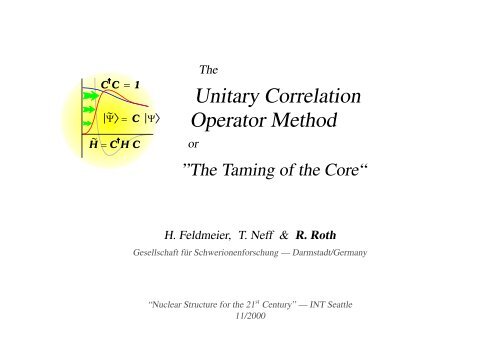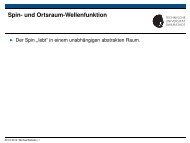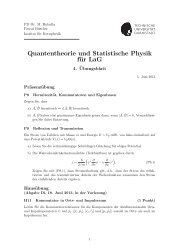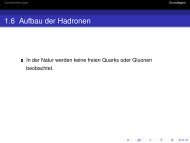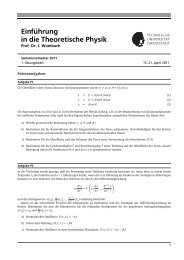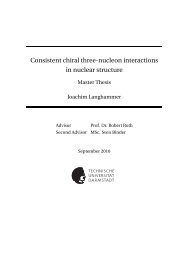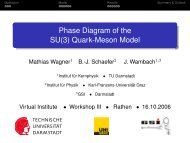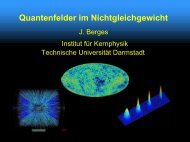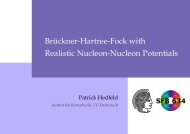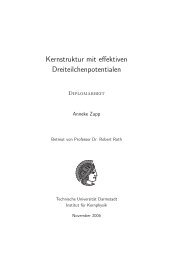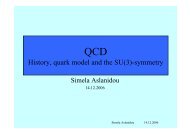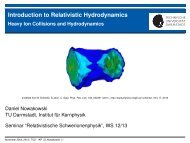Unitary Correlation Operator Method
Unitary Correlation Operator Method
Unitary Correlation Operator Method
You also want an ePaper? Increase the reach of your titles
YUMPU automatically turns print PDFs into web optimized ePapers that Google loves.
dummy text to get landscape orientation...dummy text to get landscape orientation...dummy text to get<br />
landscape orientation...<br />
The<br />
<strong>Unitary</strong> <strong>Correlation</strong><br />
<strong>Operator</strong> <strong>Method</strong><br />
or<br />
”The Taming of the Core“<br />
H. Feldmeier, T. Neff & R. Roth<br />
Gesellschaft für Schwerionenforschung — Darmstadt/Germany<br />
“Nuclear Structure for the 21 st Century” — INT Seattle<br />
11/2000
Why Effective Interactions?<br />
The Problem: Short-Range <strong>Correlation</strong>s<br />
Interaction<br />
many realistic two-body<br />
interactions show a strong<br />
short-range repulsion<br />
(e.g. nucleon-nucleon & van der<br />
Waals interactions)<br />
Effective Interaction<br />
replace the full potential by a<br />
tamed effective interaction<br />
<strong>Correlation</strong>s<br />
core induces strong<br />
short-range correlations<br />
in many-body state<br />
(e.g. correlation hole in<br />
two-body density)<br />
<strong>Unitary</strong> <strong>Correlation</strong> <strong>Operator</strong> <strong>Method</strong><br />
UCOM<br />
Product States<br />
short-range correlations<br />
cannot be described by<br />
product-type states<br />
(e.g. mean-field, superposition<br />
of few product states,...)<br />
Correlated States<br />
include correlations in many-body<br />
model-space<br />
R. Roth
G † = G<br />
C † C = 1<br />
Concept of the<br />
<strong>Unitary</strong> <strong>Correlation</strong> <strong>Operator</strong> <strong>Method</strong><br />
<strong>Correlation</strong> <strong>Operator</strong><br />
Short-range correlations are represented by a<br />
state-independent unitary correlation operator C that<br />
describes a radial distance-dependent shift in the<br />
relative coordinate of the two-body system.<br />
<br />
C = exp[−i G] = exp − i <br />
gij Correlated States<br />
<br />
ψ = C ψ <br />
g = 1 r<br />
2 [ s(r) r<br />
i
Correlated Wave Function<br />
Malfliet-Tjon V potential<br />
• correlator acts on the relative part of the<br />
two-body wave function<br />
<br />
r, X C ψ = R−(r) R−(r) r<br />
r , X ψ <br />
<br />
r, X C † ψ = R+(r) R+(r) r<br />
r , X ψ <br />
• norm-conserving coordinate transformation<br />
[a.u.]<br />
1<br />
0.5<br />
0<br />
-0.5<br />
r ↦→ R±(r) r<br />
r<br />
r φ r C φ <br />
v(r)<br />
0 1 2 3<br />
r [fm]<br />
Two-Body System<br />
Correlated Wave Function<br />
<strong>Correlation</strong> Function R±(r)<br />
• metric factor and inverse transformation<br />
R±(r) = R±(r)<br />
r<br />
• connection with s(r)<br />
[fm]<br />
0.15<br />
0.1<br />
R±(r) dξ<br />
±1 =<br />
s(ξ)<br />
r<br />
R+(r) − r<br />
R±[R∓(r)] = r<br />
[fm]<br />
2<br />
1<br />
<br />
R ′ ± (r)<br />
R±(r) ≈ r ± s(r)<br />
R+(r)<br />
R−(r)<br />
0.05<br />
0<br />
0 1 2 3<br />
0<br />
r [fm]<br />
0 1 2 3<br />
r [fm]<br />
R. Roth
Lennard-Jones potential<br />
[a.u.]<br />
1<br />
0.5<br />
0<br />
-0.5<br />
r φ <br />
r C φ <br />
v(r)<br />
0 2 4 6 8 10<br />
r [ ˚A]<br />
[ ˚A]<br />
1.5<br />
1<br />
R+(r) − r<br />
[ ˚A]<br />
8<br />
6<br />
4<br />
2<br />
R+(r)<br />
R−(r)<br />
0.5<br />
0<br />
0 2 4 6 8 10<br />
0<br />
r [ ˚A]<br />
0 2 4 6 8 10<br />
r [ ˚A]
Many-Body System<br />
Correlated <strong>Operator</strong>s & Cluster Expansion<br />
Cluster Expansion<br />
decompose the correlated operator into<br />
a sum of irreducible k-body operators<br />
H = C † H C = H [1] + H [2] + H [3] + · · ·<br />
if the range of correlations is small compared<br />
to the average distance between the particles<br />
then higher cluster orders are negligible<br />
Two-Body<br />
Approximation<br />
H C2 = H [1] + H [2]<br />
Smallness Parameter<br />
κ = ρ VC<br />
κ ≪ 1 κ ≪/ 1<br />
Effective Corrections<br />
e.g. density-dependent<br />
correlation functions<br />
in H C2<br />
Cluster<br />
Decomposition<br />
Principle<br />
<br />
VC = d 3 r r C 1 − r 1 2 <br />
= d 3 r [R+(r) − 1] 2<br />
Three-Body<br />
Approximation<br />
H C3 = H [1] + H [2] + H [3]<br />
R. Roth
Local Potentials<br />
Two-Body Approximation<br />
Correlated Hamiltonian & Effective Interaction<br />
v(r) = v[R+(r)]<br />
u(r) =<br />
2µR ′ +<br />
′′<br />
1 2R +(r)<br />
2<br />
(r)<br />
H = T0 + <br />
i
The Basics of<br />
Fermionic Molecular Dynamics<br />
One-Body States<br />
x ψ =<br />
n<br />
ν=1<br />
ξν : mean position<br />
πν : mean momentum<br />
αν : complex width<br />
<br />
exp − (x − ξν) 2<br />
2 αν<br />
Many-Body State<br />
m<br />
− i πνx<br />
s <br />
ν ⊗ m t<br />
• 8n variational parameters<br />
per nucleon<br />
<br />
Ψ = C A ψ1 ⊗ ψ2 ⊗ · · · ⊗ ψA<br />
• exactly antisymmetrized product states<br />
• short-range correlations described by UCOM<br />
Structure<br />
• energy minimization by variation of the parameters<br />
gives groundstate wave function<br />
• diagonalization within a small subspace (spanned by<br />
rotation & scaling of the variational groundstate)<br />
Dynamics<br />
• time-dependent variational principle yields equations<br />
of motion for the parameters<br />
R. Roth
[AMeV]<br />
40<br />
20<br />
0<br />
-20<br />
-40<br />
-60<br />
15.09<br />
-12.59<br />
4 He<br />
2.50<br />
18.90<br />
-7.62<br />
-26.52<br />
intrinsic kinetic energy<br />
potential energy<br />
total energy<br />
20.79<br />
Malfliet-Tjon-V Potential<br />
Groundstate Energies<br />
5 He 6 He 7 Li 8 Be<br />
3.46<br />
25.52<br />
-34.01<br />
26.13<br />
4.07<br />
32.26<br />
33.58<br />
3.81<br />
-7.83<br />
-8.49<br />
-17.33<br />
-8.6<br />
-11.00<br />
-22.06<br />
-11.06<br />
-14.91<br />
(-11.91)<br />
-43.26<br />
-29.76<br />
41.57<br />
-56.48<br />
39.03<br />
3.52<br />
-35.52<br />
reference<br />
SVM • Varga, Suzuki; Phys. Rev. C52(95)2885<br />
VMC • Wiringa; priv. comm. in Phys. Rev. C52(95)2885; except 7 Li<br />
49.08<br />
-19.81<br />
-68.89<br />
R. Roth
Afnan-Tang S3M Potential<br />
Spin-Isospin Dependent NN-Potentials<br />
Spin-Isospin Dependent Central Interaction<br />
• central two-body potential expressed by projection<br />
operators ΠST on spin S and isospin T<br />
v = <br />
S,T<br />
• e.g. Afnan-Tang S3M potential<br />
vST (r) ΠST<br />
Spin-Isospin Dependent Correlator<br />
• unitary transformation depending on the (S, T ) quantum<br />
numbers of the particle pair (two-body space)<br />
<br />
c = exp −i <br />
= <br />
S,T<br />
g ST ΠST<br />
S,T<br />
exp(−i gST ) ΠST = <br />
cST ΠST<br />
S,T<br />
• different correlation function R ST<br />
+ (r) for each (S, T )component<br />
of the potential<br />
[MeV]<br />
100<br />
50<br />
0<br />
-50<br />
-100<br />
[fm]<br />
0.2<br />
0.15<br />
0.1<br />
0.05<br />
0<br />
vST (r)<br />
ST =<br />
01<br />
10<br />
00 & 11<br />
R ST<br />
+ (r) − r<br />
0 1 2 3<br />
r [fm]<br />
[Phys. Rev. 175 (1968) 1337], [Nucl. Phys. A371 (1981) 79]<br />
R. Roth
Afnan-Tang S3M Potential<br />
Groundstate Energies<br />
dummy text to get landscape orientation...dummy text to get landscape orientation...dummy text to get<br />
landscape orientation...<br />
R. Roth
y [fm]<br />
y [fm]<br />
6<br />
4<br />
2<br />
0<br />
-2<br />
-4<br />
-6<br />
1.0<br />
1.5<br />
0.5<br />
0.1<br />
0.01<br />
4 He<br />
y [fm]<br />
6<br />
4<br />
2<br />
0<br />
-2<br />
-4<br />
-6<br />
Afnan-Tang S3M Potential<br />
Groundstate Densities<br />
ρ(r) [ρ [ρ0] 0]<br />
10 -1<br />
10 -1<br />
10 -2<br />
10 -2<br />
0.1<br />
0.5<br />
0.01<br />
1<br />
1.0<br />
10 -3<br />
10 -3<br />
10 -4<br />
10 -4<br />
0.01<br />
total<br />
neutron<br />
proton<br />
y [fm]<br />
7 Li<br />
6<br />
4<br />
2<br />
0<br />
-2<br />
-4<br />
-6<br />
ρ(r) [ρ [ρ0] 0]<br />
4 He<br />
6 -6 -4 -2 0 2 4 6 -6 -4 -2 0 0 1 2 2 4 3 6 -6 4 -4 5 -2 0 0 1 2 2 4 3 6 -6 4 -4 5 -2 0 0 1 2 2 4 3 6 4 5 0<br />
20 24 20 28 24 40 28<br />
x [fm] Ne<br />
1 x [fm] r Mg [fm] Ne 1 x [fm] r [fm] Si Mg 1 x [fm] r [fm] Ca Si 1<br />
4<br />
4<br />
4<br />
4<br />
2<br />
0<br />
-2<br />
-4<br />
-6<br />
1.0<br />
0.01<br />
0.01<br />
0.5<br />
0.1<br />
0.1<br />
y [fm]<br />
-2<br />
-4<br />
-6<br />
-6 -4 -2 0<br />
x [fm]<br />
2 4 6<br />
2<br />
0<br />
ρ(r) [ρ [ρ0] 0]<br />
0.1<br />
0.01<br />
0.01<br />
10 -1<br />
10 -1<br />
10 -2<br />
10 -2<br />
1.0<br />
0.5<br />
10 -3<br />
10 -3<br />
10 -4<br />
10 -4<br />
• one gaussian per nucleon, fixed spin<br />
0.1<br />
0.5<br />
total<br />
neutron<br />
proton<br />
y [fm]<br />
2<br />
0<br />
-2<br />
-4<br />
-6<br />
ρ(r) [ρ [ρ0] 0]<br />
0.1<br />
0.01<br />
10 -1<br />
10 -1<br />
1.0<br />
1<br />
10 -2<br />
10 -2<br />
10 -3<br />
10 -3<br />
0.5<br />
0.1<br />
0.01<br />
10 -4<br />
10 -4<br />
10 -1<br />
10 -1<br />
10 -2<br />
10 -2<br />
1.0<br />
0.5<br />
10 -3<br />
10 -3<br />
10 -4<br />
10 -4<br />
0.01<br />
1.0<br />
0.01<br />
0.1<br />
1.0<br />
total<br />
neutron<br />
proton<br />
0.1<br />
total<br />
neutron<br />
proton<br />
12 C<br />
y [fm]<br />
6<br />
4<br />
2<br />
0<br />
-2<br />
-4<br />
-6<br />
ρ(r) [ρ [ρ0] 0]<br />
7 Li<br />
1<br />
10 -1<br />
10 -1<br />
10 -2<br />
10 -2<br />
1.0<br />
0.5<br />
10 -3<br />
10 -3<br />
0.1<br />
0.01<br />
10 -4<br />
10 -4<br />
0.01<br />
0.1<br />
total<br />
neutron<br />
proton<br />
-6 -4 -2 0 0 1 2 2 4 3 6 -6 4 -4 5 -2 0 0 1 2 2 4 3 6 -6 4 -4 5 -2 0 0 1 2 2 4 3 6 4 5<br />
x [fm] r [fm]<br />
x [fm] r [fm]<br />
x [fm] r [fm]<br />
y [fm]<br />
2<br />
0<br />
-2<br />
-4<br />
-6<br />
ρ(r) [ρ [ρ0] 0]<br />
0.01<br />
10 -1<br />
10 -1<br />
10 -2<br />
10 -2<br />
0.5<br />
1.0<br />
10 -3<br />
10 -3<br />
0.1<br />
0.01<br />
10 -4<br />
10 -4<br />
0.1<br />
1.5<br />
0.5<br />
total<br />
neutron<br />
proton<br />
16 O<br />
0.01<br />
R. Roth<br />
ρ(r) [ρ [ρ0] 0]<br />
ρ(r) [ρ [ρ0] 0]<br />
12 C<br />
1<br />
10 -1<br />
10 -1<br />
10 -2<br />
10 -2<br />
10 -3<br />
10 -3<br />
10 -4<br />
10 -4<br />
10 -1<br />
10 -1<br />
10 -2<br />
10 -2<br />
10 -3<br />
10 -3<br />
10 -4<br />
10 -4<br />
0
Outlook<br />
Summary<br />
UCOM & FMD<br />
Summary & Outlook<br />
• <strong>Unitary</strong> <strong>Correlation</strong> <strong>Operator</strong> <strong>Method</strong> describes short-range<br />
correlations by a distance-dependent transformation in the relative<br />
two-body coordinate<br />
• correlated Hamiltonian / effective interaction in two-body<br />
approximation is given in closed form; higher cluster orders are<br />
negligible in case of finite nuclei<br />
• variational model based on a Slater determinant of Gaussian trial<br />
states (Fermionic Molecular Dynamics) to describe groundstate<br />
structure of light and intermediate mass nuclei<br />
• for central potentials (MTV/ATS3M) the results are comparable<br />
with quasi-exact and expensive many-body techniques<br />
• need realistic NN-interaction, e.g. Bonn or Argonne potential,<br />
including a proper treatment of tensor correlations<br />
• ready for systematic and nearly ab initio nuclear structure studies<br />
• can be used for the description of low-energy nucleus-nucleus<br />
collisions right away<br />
R. Roth


